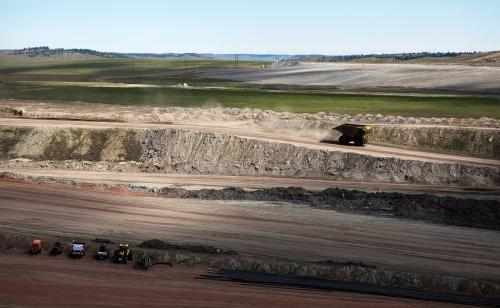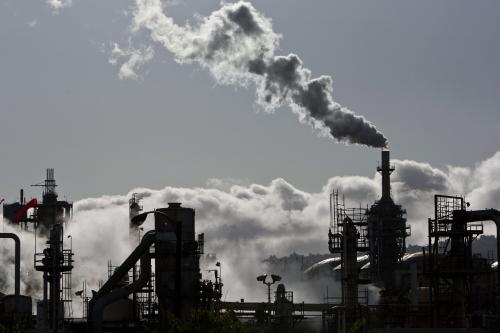President Trump has made empty promises to make the coal industry great again, vowing to reverse decades of the industry’s downward employment trajectory. In previous blog posts (see here and here), we have shown how his promises to put coal miners back to work will be a tall order. Here, we introduce another reason why coal will face an uphill battle: automation.
The problem facing the coal industry is not unique: Automation is rapidly reducing employment in mining and manufacturing. Across a wide range of industries, from car manufacturing to computing, robots or artificial intelligence are increasingly taking over roles traditionally performed by humans. The same is true for coal mining.
More importantly, automation has been eating into coal jobs over a long period of time—years before concerns about climate change led to the environmental regulations that President Trump solely blames for the industry’s decline. Nationwide, employment in the coal mining industry peaked in 1920, when it employed roughly 785,000 people. The more recent decline started in 1980, when the industry employed approximately 242,000 people. By 2000, 15 years before the Environmental Protection Agency first proposed the Clean Power Plan and released new pollution guidelines to cut toxic emissions from power plants, industry employment had dropped to 102,000. By 2015, coal mining had shed 59 percent of its workforce, compared to 1980.

During the same period, coal production grew by 8 percent, to about 897 million short tons in 2015 (23 percent below its 2008 peak). At the same time, coal mining productivity jumped from 1.93 short tons per miner hour in 1980 to 6.28 short tons per miner hour in 2015.
One of the early harbingers of automation in coal mining was the shift from underground coal mines in the Appalachian region to the open pit mines of the West (especially in Montana and Wyoming). Surface mining—also known as mountaintop removal mining, in which miners use controlled explosions to open mountains and mine the newly exposed coal seams—is less labor-intensive and more automated than traditional underground mining. Between 1980 and 2015, underground mining’s share of total coal production dropped from 41–35 percent, while surface mining production increased from 59–65 percent. Coal companies in the Powder River Basin in Montana and Wyoming can extract more than 11 times as much coal per employee hour as coal companies in the Appalachian Basin.

Wyoming passed West Virginia in the 1980s to become the biggest coal-producing state, and has mostly built on its lead since then to account for 42 percent of the nation’s current production. According to the U.S. Energy Information Administration, Wyoming has four times the recoverable reserves in producing mines as West Virginia—and about twice as much as West Virginia, Pennsylvania, and Ohio combined. In 2015, Wyoming’s mines employed many fewer people but produced four times as much coal as West Virginia.
In the next decade, the coal mining industry will likely lose even more jobs to automation. According to a report from the International Institute for Sustainable Development (IISD) in Winnipeg, Canada, the mining industry is primed for automation. It is highly capital intensive, pays relatively well, and buys expensive equipment. The industry has already adopted various automated technologies, including autonomous haul trucks and loaders; autonomous long-distance haul trains; semi-autonomous crushers, rock breakers, and shovel swings; automated drilling and tunnel-boring systems; automated long-wall plough and shearers; autonomous equipment monitoring; and GIS and GPS technologies. All of these technologies are already in use, and their deployment will be ramped up in the next 10–15 years.
Not all of these automated technologies will have a similar impact on mining employment. Autonomous haul trucks, for instance, will have a greater impact in a relatively short time compared to, for instance, the adoption of GIS and GPS technologies. The IISD report concludes that automation is likely to replace 40–80 percent of workers in a mine, with newer mines and those with many years of life left most susceptible to automation.
In the end, coal workers’ faith in President Trump doesn’t matter much: coal jobs are not coming back. Given that stark reality, President Trump must focus his energy on crafting policies that would ensure a fair transition for coal workers. In this regard, our colleague Adele Morris has argued that federal support will be critical to helping dislocated coal workers and has proposed a carbon tax to fund a generous transitional assistance package. Similarly, both the federal and state governments should invest heavily in public education and retraining programs that would enable coal workers to find new career paths outside the coal mining industry. A recent study, for instance, has shown that growth in the solar industry can absorb all U.S. coal workers who will be laid off during the next 15 years.
The coal industry is changing dramatically, with job losses mounting continually. Automation will just add to the pressure the industry faces from a variety of forces. Taking care of affected coal workers will require big-picture thinking on the part of the new administration.
The Brookings Institution is committed to quality, independence, and impact.
We are supported by a diverse array of funders. In line with our values and policies, each Brookings publication represents the sole views of its author(s).







Commentary
Increased automation guarantees a bleak outlook for Trump’s promises to coal miners
January 25, 2017